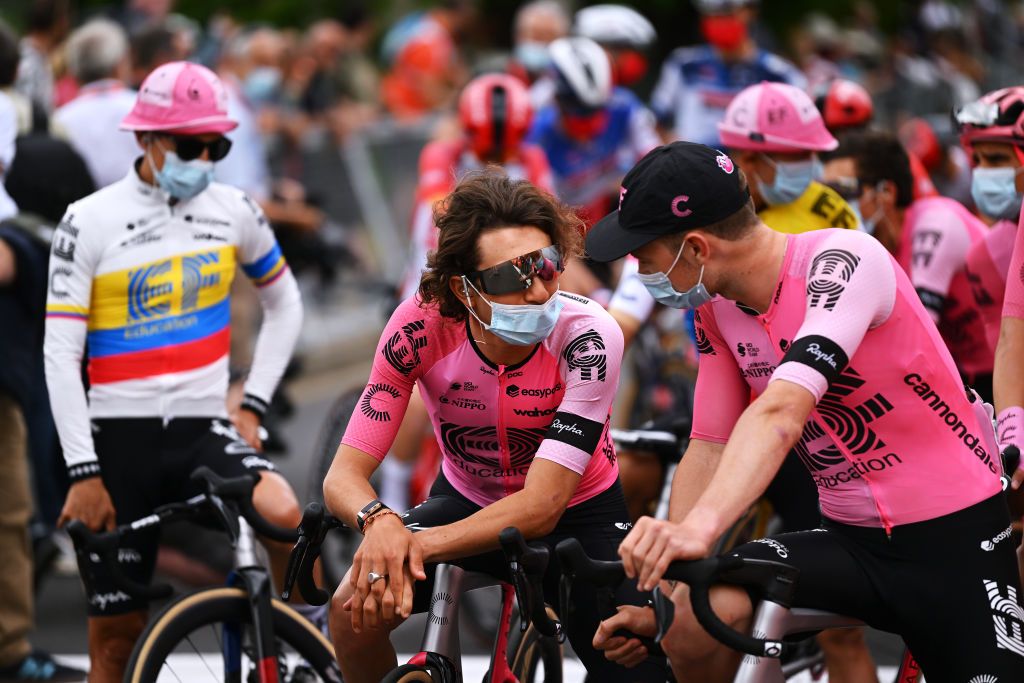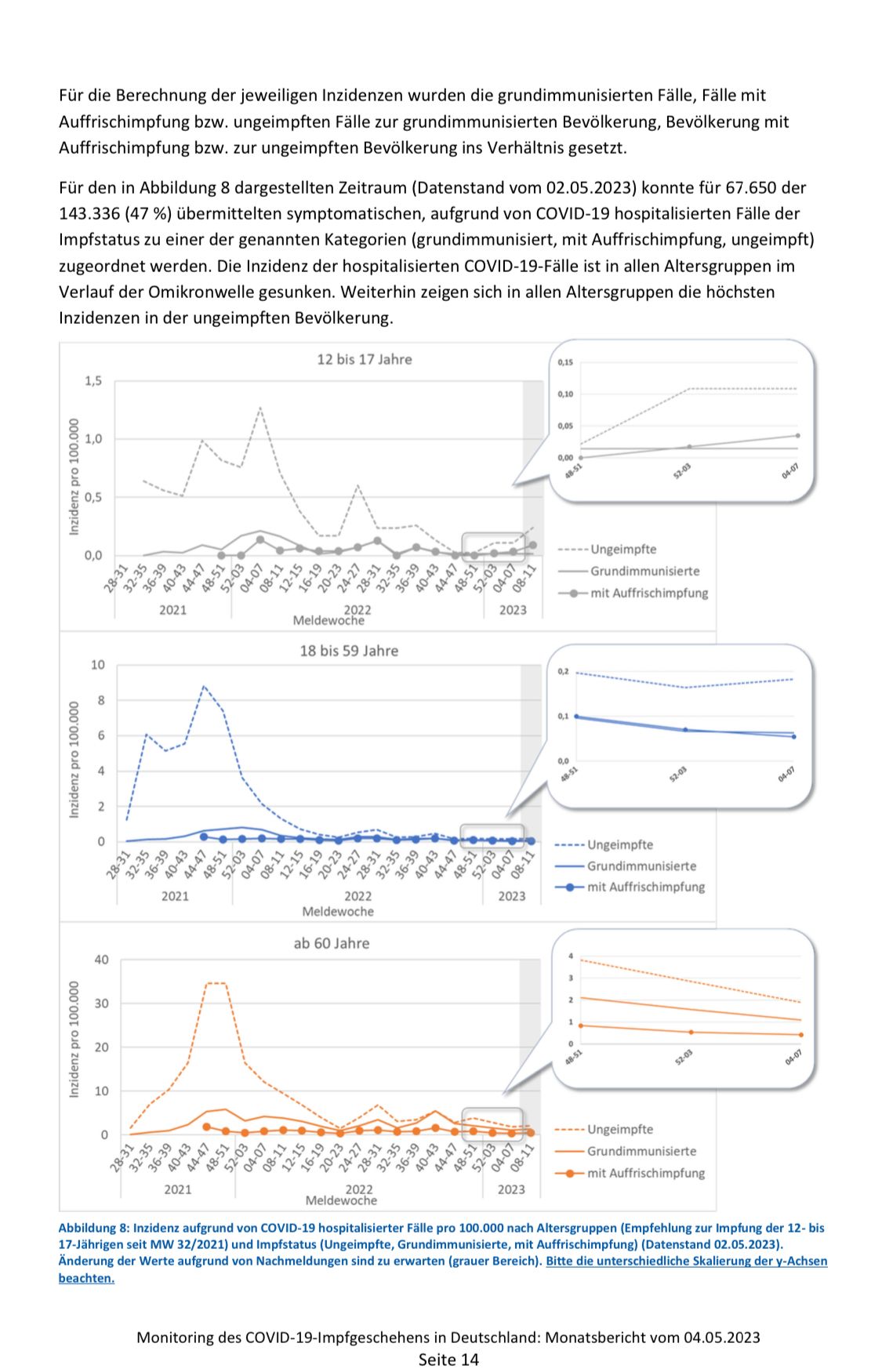Tales from Coronavee-rooss Italy, mamma mia!
-
-
@lolwhat said in Tales from Coronavee-rooss Italy, mamma mia!:
So many brains were damaged permanently by covid.
Just yesterday I was scolded by a family member for not remembering mass graves filled with heaps of bodies moved by bulldozers (no such thing happened).
-
@MrL said in Tales from Coronavee-rooss Italy, mamma mia!:
@lolwhat said in Tales from Coronavee-rooss Italy, mamma mia!:
So many brains were damaged permanently by covid.
Just yesterday I was scolded by a family member for not remembering mass graves filled with heaps of bodies moved by bulldozers (no such thing happened).
So, we're getting some "fun" Mandela effects with this shit now?
-
@Carnage said in Tales from Coronavee-rooss Italy, mamma mia!:
@MrL said in Tales from Coronavee-rooss Italy, mamma mia!:
@lolwhat said in Tales from Coronavee-rooss Italy, mamma mia!:
So many brains were damaged permanently by covid.
Just yesterday I was scolded by a family member for not remembering mass graves filled with heaps of bodies moved by bulldozers (no such thing happened).
So, we're getting some "fun" Mandela effects with this shit now?
Of course. Fabricated memories are core parts of media victims, just like selective amnesia.
-
@Carnage I’m still waiting for when all vaccinated people die in September.
Clever enough, though, they never specified which September.
-
@topspin You do realise that you could just as easily say the complete opposite?
-
@GOG What would that exact opposite even be? Not waiting for the unvaccinated to not die in a particular September which they stupidly always specified? Or would you have to deMorgan that somehow?
-
@GOG You do realize that’s what the posts right above are about? Kind of ironic, your post would have made sense if either 1) I posted this first, or 2) you’d have directed it at the posts above mine.
But I guess it’s only valid to point in one direction.Anyway, I don’t remember people saying “all unvaccinated people will die”.
-
@topspin Funny, because I absolutely do.
-
@GOG must be the fabricated memories.
Unless you’re messing up your quantifiers. It was more unvaccinated people will die than vaccinated. But one is crazy and the other is factual, so that’s not comparable.
-
@topspin To-may-to, to-mah-to. As things stand, the evidence for covid vaccines actually doing anything useful is... what's the nice word... inconclusive. And the evidence for them doing harm is also inconclusive and that should scare the pants off of you if you actually bothered to think about it.
-
@GOG said in Tales from Coronavee-rooss Italy, mamma mia!:
@topspin To-may-to, to-mah-to.
That already disqualifies pretty much everything else you said. Again, one is completely crazy, the other is not.
As things stand, the evidence for covid vaccines actually doing anything useful is... what's the nice word... inconclusive.
Not really.
-
@topspin Yes, really. Poland capped out at around 57% of the population receiving at least one dose of the vaccine around a year ago. This means that nearly half of our population is completely unvaccinated.
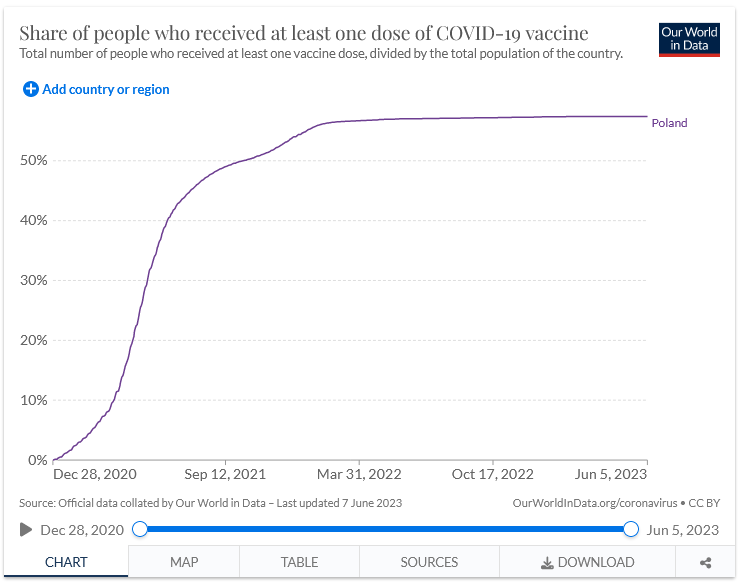
If the vaccine was such a big game-changer as was claimed, the fact that nearly half the population isn't vaccinated would show up in the national statistics.
So, what do the case numbers and deaths look like?
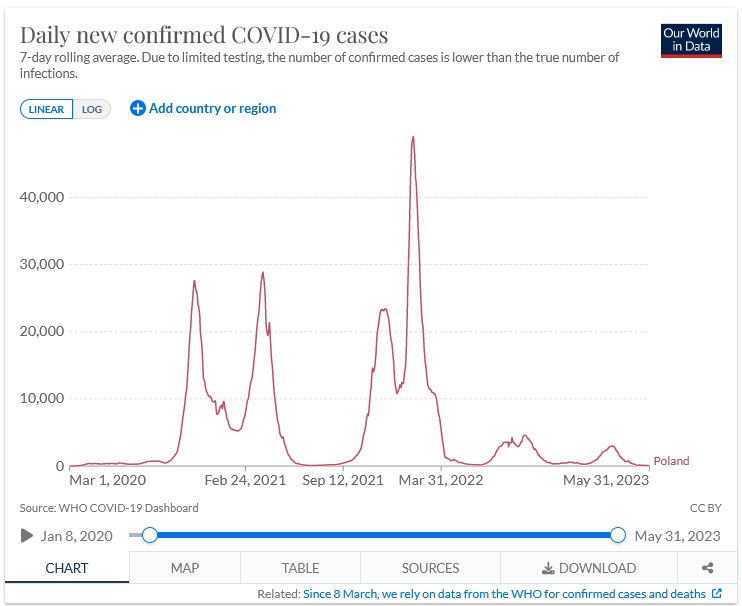
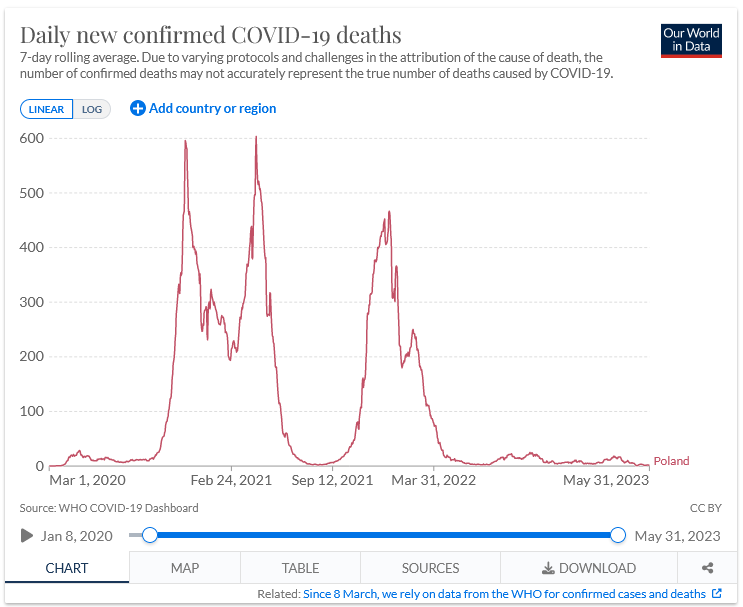
The highest peak infections came when we were already at essentially as high a level of vaccination as we are likely to get - higher than when nobody was vaccinated, because there was no vaccine.
Similarly, mortality in late 2021 is not significantly lower than it was in late 2020 (with no vaccine) - the daily peak is lower, but the entire elevated mortality period is longer. On the other hand - the mortality uptick over the 2022-2023 is negligible, compared to prior peaks with no significant change in the number of people who have received any vaccine. Vaccination cannot explain the difference between 2021-2022 and 2022-2023 seasons - either in terms of infections or deaths - because it hasn't changed in the interim.
You can't even claim that the covid deaths are simply unaccounted for as such because gross deaths over the winer season (which I'll count here as Nov-Feb) were:
11.2020: 66k
12.2020: 54.3k
01.2021: 46.2k
02.2021: 40k11.2021: 50,9k
12.2021: 61.1k
01.2022: 48.3k
02.2022: 41.7k11.2022: 33.8k
12.2022: 40.6k
01.2023: 42.5k
02.2023: 33.0kBy way of comparison, in the 2017-2018 season (clearly before covid, but close enough to hopefully avoid too many confounders), the numbers were:
11.2017: 32.4k
12.2017: 33.3k
01.2018: 39.7k
02.2018: 36.8k
-
-
@topspin I am aware of the evidence in favour.
-
@GOG so you’re aware that “more unvaccinated people die[d] than vaccinated” was, in fact, factual amongst age groups and over time.

-
@topspin Yes. And? When you're proposing a population-level intervention, you need to examine its effects on the population level.
The claim has never been that the vaccine offers no benefits, only that the benefit it offers to the modal recipient is negligible because most people weren't ever in any significant danger from covid.
-
@GOG just wanted to make sure that you’re still claiming facts and crazy and nonsense are to-may-to, to-mah-to.
-
@topspin Dude, you've already demonstrated you're not the sharpest tool in the drawer when it comes to these things, so I don't know why I even bother.
Nevertheless, I will. You saying that it was a simple claim of "more unvaccinated people will die than vaccinated" is what we call a lie. This wasn't the claim. The claim was "pandemic of the unvaccinated".
By the very data you have posted, the difference between "unvaccinated" and "vaccinated with booster" in the most vulnerable segment (60+) is 2 to ~0.5 per 100,000 in the latest period. Those are "Moon is in the Seventh House and Jupiter aligns with Mars" level differences.
-
Not that I'm a saint, but we're not in the Garage.
-
@lolwhat That's why I'm moderating my language.
-
@GOG said in Tales from Coronavee-rooss Italy, mamma mia!:
Nevertheless, I will. You saying that it was a simple claim of "more unvaccinated people will die than vaccinated" is what we call a lie. This wasn't the claim. The claim was "pandemic of the unvaccinated".
Let's not forget that after vaccination you are considered unvaccinated for first 2 weeks, and as we know from Pfizer papers the most common vax side effect is full blown covid

-
@MrL I'm not gonna comment on that, not having looked at it, but will note that this allows you to magic effectiveness out of thin air, simply by discounting anyone who happens to get sick (or die) within two weeks of getting vaccinated.
It's not that big an issue now, because there isn't a big vaccination push anymore. However, let me offer a prediction that the difference between "vaccinated" and "unvaccinated" when it comes to effects of covid will trend towards zero in the long run.
-
@GOG said in Tales from Coronavee-rooss Italy, mamma mia!:
@topspin Dude, you've already demonstrated you're not the sharpest tool in the drawer when it comes to these things, so I don't know why I even bother.
No U.
Nevertheless, I will. You saying that it was a simple claim of "more unvaccinated people will die than vaccinated" is what we call a lie. This wasn't the claim. The claim was "pandemic of the unvaccinated".
By the very data you have posted, the difference between "unvaccinated" and "vaccinated with booster" in the most vulnerable segment (60+) is 2 to ~0.5 per 100,000 in the latest period. Those are "Moon is in the Seventh House and Jupiter aligns with Mars" level differences.
Yeah, looking at a period where it’s low for all is totally meaningful. It’s somewhere around 35 to 2 in the relevant parts. Still, the difference is clear across the board.
-
@GOG said in Tales from Coronavee-rooss Italy, mamma mia!:
@MrL I'm not gonna comment on that, not having looked at it, but will note that this allows you to magic effectiveness out of thin air, simply by discounting anyone who happens to get sick (or die) within two weeks of getting vaccinated.
Yeah, simulating this by yourself with pen and paper is pretty eye opening.
It's not that big an issue now, because there isn't a big vaccination push anymore. However, let me offer a prediction that the difference between "vaccinated" and "unvaccinated" when it comes to effects of covid will trend towards zero in the long run.
There was an amusing speech about it in British parliament.
-
@topspin said in Tales from Coronavee-rooss Italy, mamma mia!:
Yeah, looking at a period where it’s low for all is totally meaningful. It’s somewhere around 35 to 2 in the relevant parts. Still, the difference is clear across the board.
Not saying it isn't, merely that it's irrelevant.
-
@MrL said in Tales from Coronavee-rooss Italy, mamma mia!:
simulating this by yourself
Due to a combination of sleep deprivation, insufficient caffeine, and needing new glasses, my brain added an extra
tto this and moved this into the NSFW thread.Filed under: Stimulating reading
-
@GOG said in Tales from Coronavee-rooss Italy, mamma mia!:
@topspin Yes, really. Poland capped out at around 57% of the population receiving at least one dose of the vaccine around a year ago. This means that nearly half of our population is completely unvaccinated.
[...]
The highest peak infections came when we were already at essentially as high a level of vaccination as we are likely to get - higher than when nobody was vaccinated, because there was no vaccine.Let's start with the basics that have been discussed for what feels like half a century now. Please check.
The COVID19 vaccine is
[ ] a sterilizing vaccine
[ ] a non-sterilizing vaccineThis means it protects against
[ ] infections
[ ] severe symptomsIf Poland has 57% vaccinated, that's not a random sample of the population but they probably started with the oldest working down as in other countries. 57% corresponds to the entire population 38 and upwards.
 to piece together what this demographic's cumulative relative risk is but I bet they have well 90% of total Covid deaths among them, so obviously you'd expect to see diminishing returns for countries that have higher vaccination rates.
to piece together what this demographic's cumulative relative risk is but I bet they have well 90% of total Covid deaths among them, so obviously you'd expect to see diminishing returns for countries that have higher vaccination rates.Still, Poland's case fatality rate is currently almost twice the world average (suggesting that in place of some of the under-38s that were in fact vaccinated a bunch of geezers didn't want the jab and are now getting the results) and 2-4 times that of some neighbors, but conspicuously it dropped sharply during 2021:
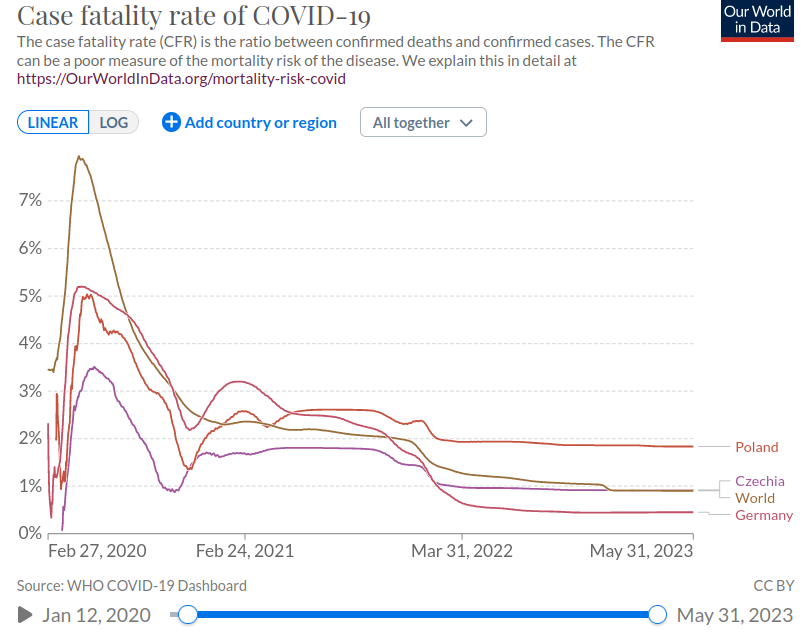
-
@LaoC said in Tales from Coronavee-rooss Italy, mamma mia!:
Still, Poland's case fatality rate is currently almost twice the world average (suggesting that in place of some of the under-38s that were in fact vaccinated a bunch of geezers didn't want the jab and are now getting the results)
No, that's just what you get when you instruct whole "healthcare" system to slap 'covid' on everything that moves (or rather doesn't).
-
Pfizer and Moderna had a large succes (at least in terms of
 ). Now they succesfully block development of newer corona vaccines by other companies / research institutions:
). Now they succesfully block development of newer corona vaccines by other companies / research institutions:Developing better products requires comparisons with existing shots that Pfizer and Moderna won’t allow

-
-
-
@jinpa said in Tales from Coronavee-rooss Italy, mamma mia!:
"If we see harmful misinformation on the platform, then we take it down. It's against our policy."
Zuck forgot to add "unless it generates clicks".
-
@LaoC said in Tales from Coronavee-rooss Italy, mamma mia!:
@jinpa said in Tales from Coronavee-rooss Italy, mamma mia!:
"If we see harmful misinformation on the platform, then we take it down. It's against our policy."
Zuck forgot to add "unless it generates clicks".
Maybe now. That certainly hasn't been the policy for the last few years.
-
@LaoC said in Tales from Coronavee-rooss Italy, mamma mia!:
Still, Poland's case fatality rate is currently almost twice the world average (suggesting that in place of some of the under-38s that were in fact vaccinated a bunch of geezers didn't want the jab and are now getting the results) and 2-4 times that of some neighbors, but conspicuously it dropped sharply during 2021:
You mean "dropped as we started going into the first big Covid season"?
The big drop you see in CFR, as shown here (separated out from other countries for clarity):
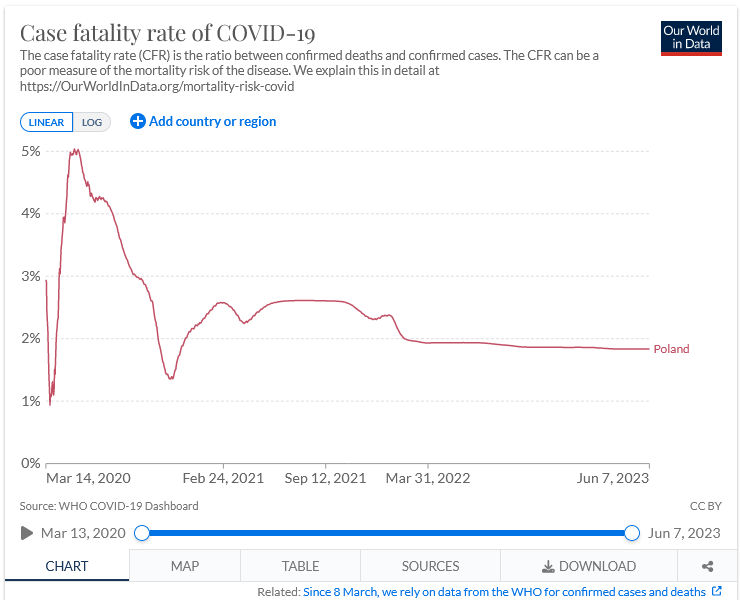
is the result of going from "a few (relatively) severe cases" to "many not severe cases". Here it is magnifiied:
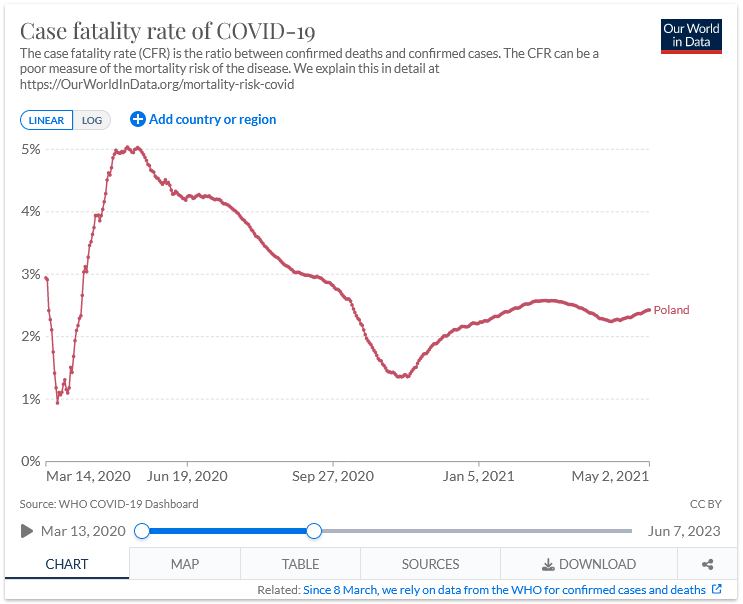
You'll notice that it hit a minimum in early November 2020 - still before the vaccine. This is the result of new cases exploding, but not translating into deaths, yet (CFR being number of deaths per number of cases.) The CFR subsequently grew to a more-or-less constant level throughout 2021, through early 2022.
Incidentally, the dips in the graph coincide with peak infections, for reasons that should be immediately obvious to anyone who understands the CFR formula.
The change in the percentage of people vaccinated at the start of the 2021-2022 wave and the latter CFR drop was from ~50% to around 56%, so you need to figure out why having half the population vaccinated doesn't give you noticeably better results than last year with no vaccination whatsoever, but vaccinating 6% more suddenly gives you a meaningful reduction (the step-wise dip around March 2022.)
Except, no you actually don't have to, because all you need is to take a look at the daily case numbers for the period:
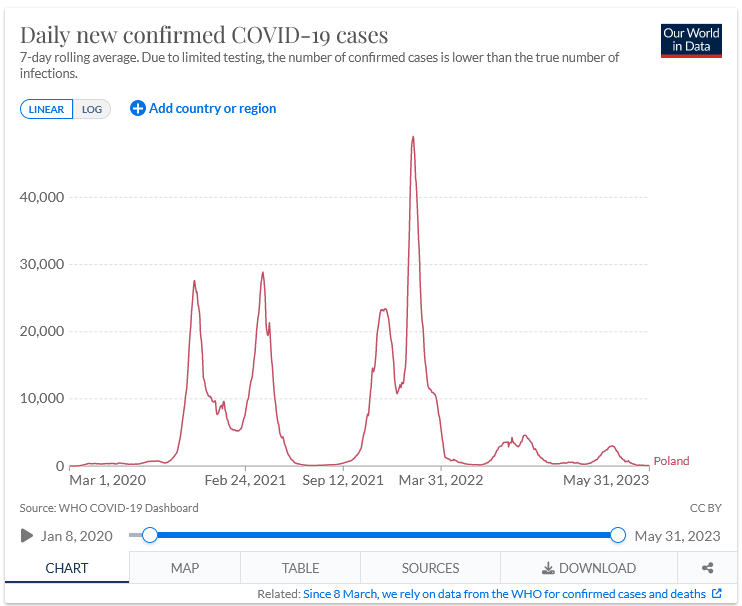
See that huge-ass peak around March 2022 (precisely the moment you get the stepwise CFR drop)? That's Omicron, which happens to be significantly more infectious than earlier variants (which is why you have almost twice the peak infections), and also significantly less deadly.
After that, the formula for CFR takes care of the rest.
-
@GOG said in Tales from Coronavee-rooss Italy, mamma mia!:
@LaoC said in Tales from Coronavee-rooss Italy, mamma mia!:
Still, Poland's case fatality rate is currently almost twice the world average (suggesting that in place of some of the under-38s that were in fact vaccinated a bunch of geezers didn't want the jab and are now getting the results) and 2-4 times that of some neighbors, but conspicuously it dropped sharply during 2021:
You mean "dropped as we started going into the first big Covid season"?
The big drop you see in CFR, as shown here (separated out from other countries for clarity):

is the result of going from "a few (relatively) severe cases" to "many not severe cases". Here it is magnifiied:

You'll notice that it hit a minimum in early November 2020 - still before the vaccine. This is the result of new cases exploding, but not translating into deaths, yet (CFR being number of deaths per number of cases.) The CFR subsequently grew to a more-or-less constant level throughout 2021, through early 2022.
You're right that the first drop was still in 2020. But severity and infectiousness increased up to the Delta variant, so up to the fourth wave there were hardly any cases of the milder Omicron in the mix. We'd expect to see CFR to go up with the third and fourth wave, but the opposite happened. Delta killed more of each age group except for the 75+, which would be very strange if it wasn't for the fact that this group had just started to get vaccinated.
If the vaccine didn't work, you'd expect to see the same proportion of vaccinated and unvaccinated people among the deceased as in the general population, wouldn't you?
-
@LaoC Not necessarily.
The first reason has already been mentioned: the "two weeks until you count as vaccinated" approach necessarily creates an appearance of effectiveness, even if you're using an agent that cannot have any protective qualities whatsoever - like a saline injection.
The second is that you're not distinguishing between "will not" and "cannot" when it comes to the unvaccinated. I don't know if you remember, but I certainly do, the line about "you must vaccinate yourself even if covid isn't particularly dangerous to you, given your age and health, in order to protect those who are unable to get vaccinated, because the vaccine is too risky for them". It so happens that those who haven't been vaccinated due to unacceptable risk profile (and I remember the long list of conditions I had to sign off on before getting my shot), also happen to be in the groups for whom covid is the most dangerous. So you would naturally expect more people who haven't received the vaccine to die from covid, because people likely to die from covid are also likelier to not qualify for vaccination.
Lastly, I need to reiterate what I said above: the vaccine likely does... something. It's simply that it doesn't do what was claimed it does - and before you start again: yes, official claims that it will contain the spread (which it cannot do, and never could) were absolutely a thing, until they became completely unsupportable - and what it does do at no point justified the actions taken in order to promote vaccination.
My line since around March 2020, I guess, has been: covid isn't the flu, but we'd be better off treating it like it was. This holds true for the vaccines, as well, which - in practice - seem about as good as the flu ones, perhaps slightly worse.
-
@GOG said in Tales from Coronavee-rooss Italy, mamma mia!:
@LaoC Not necessarily.
The first reason has already been mentioned: the "two weeks until you count as vaccinated" approach necessarily creates an appearance of effectiveness, even if you're using an agent that cannot have any protective qualities whatsoever - like a saline injection.
How does that work statistically?
The second is that you're not distinguishing between "will not" and "cannot" when it comes to the unvaccinated. I don't know if you remember, but I certainly do, the line about "you must vaccinate yourself even if covid isn't particularly dangerous to you, given your age and health, in order to protect those who are unable to get vaccinated, because the vaccine is too risky for them". It so happens that those who haven't been vaccinated due to unacceptable risk profile (and I remember the long list of conditions I had to sign off on before getting my shot), also happen to be in the groups for whom covid is the most dangerous. So you would naturally expect more people who haven't received the vaccine to die from covid, because people likely to die from covid are also likelier to not qualify for vaccination.
Correct me if I'm wrong but as far as I know the only thing that makes you ineligible for (further) vaccination is anaphylaxis after a COVID shot, which leaves you at least partially vaccinated, or after a component of a shot. Even people with advanced HIV or organ transplants get it, so the numbers of those who can't are clearly in the range of statistical noise, or
"Moon is in the Seventh House and Jupiter aligns with Mars level" as you like to put it.Lastly, I need to reiterate what I said above: the vaccine likely does... something. It's simply that it doesn't do what was claimed it does - and before you start again: yes, official claims that it will contain the spread (which it cannot do, and never could) were absolutely a thing, until they became completely unsupportable - and what it does do at no point justified the actions taken in order to promote vaccination.
Preventing you from becoming severely ill doesn't count as "doing anything useful" for you?
-
@LaoC said in Tales from Coronavee-rooss Italy, mamma mia!:
Correct me if I'm wrong but as far as I know the only thing that makes you ineligible for (further) vaccination is anaphylaxis after a COVID shot, which leaves you at least partially vaccinated, or after a component of a shot. Even people with advanced HIV or organ transplants get it, so the numbers of those who can't are clearly in the range of statistical noise, or
"Moon is in the Seventh House and Jupiter aligns with Mars level" as you like to put it.Seems to depend on the country. Around here, heart issues, certain liver issues, and severe kidney damage all excluded you. (ETA: And are more common here than in Europe in general, nevermind South-East Asia.)
Interestingly enough, a severe reaction to the first vaccination did not, from what I hear. But that's an indication of nothing but the idiocy of the Finnish medical system.
Preventing you from becoming severely ill doesn't count as "doing anything useful" for you?
Depends on your definition of "severely ill".
Preventing the normal bed-rest -inducing flu symptoms, in otherwise healthy people that won't die of them? No, I don't consider that useful. The discomfort is passing. And the people whose symptoms got suppressed will walk around while ill, spreading the illness more. So reducing non-lethal symptoms gets counter-productive.
Preventing death in the elderly? Sure. But we weren't criticizing the vaccination of the elderly, but the healthy gen-pop.
-
@LaoC said in Tales from Coronavee-rooss Italy, mamma mia!:
How does that work statistically?
Imagine you are conducting a controlled experiment, with a covid "vaccine" that is actually a placebo - a totally neutral thing, such as a saline injection. There's no plausible mechanism by which it should do anything.
Assume that you have selected your test and control groups perfectly: we'll assume 100 people each, perfectly matched so that your test group is equally likely to get covid as your control group. You couldn't ask for a better experimental setup if you wanted to know if a real covid vaccine actually did anything, and what.
The experiment is designed to run over ten weeks. You "vaccinate" your test group at the start of week one, and see how many people end up catching covid over your trial period in both the test and control group. You assume that the "vaccine" requires two weeks before acheiving full effectiveness, therefore anyone who catches covid in the first two weeks after "vaccination" will be counted as "unvaccinated" (just like your control group).
(Since I suspect you're gonna try to be pedantic about this, you can swap out "catching" for whatever effect - hospitalisation, death - that you prefer. It doesn't change things in the slightest.)
For further ease of calculation we will assume that 10% of each group end up catching covid throughout the trial period, and that the rate of catching covid remains constant, so that 1% of each group catches covid during week one, 1% (cumulative 2%) catches covid during week two, etc. etc.
We begin the experiment and "vax" our test group. At the end of week one we find 1% of our control group caught covid, and 1% of our test group also caught covid. The "vaccine" isn't "effective", yet, so we move the people who caught covid in our "vaccinated" test group into the "unvaccinated" bin.
At the end of week two, another 1% of our control group caught covid, and another 1% of our test group caught covid, too. Our "vaccine" still isn't "effective", so we move the "vaccinated" people who caught covid into the "unvaccinated" bin again.
The experiment continues until conclusion. Since, after two weeks, our "vaccine" is considered "effective", people who catch covid in our "vaccinated" group are counted as "vaccinated".
Our results at the end of the trial period are as follows:
Out of 102 unvaccinated people (100 control, plus the 2 people from the test group we moved into the "unvaccinated" bin), 12 caught covid (the 10% of the original control who would have caught it regardless, and the two who caught covid in the test group, whom we moved into the "unvaccinated" bin) - an 11.8% incidence.
For the vaccinated group of 98 people (100 test, minus the 2 we moved into the "unvaccinated" bin, because they caught covid during the first two weeks, when the "vaccine" still wasn't "effective"), 8 caught covid (10 people in the test group have caught covid, but we moved 2 of them into the "unvaccinated" bin), giving as an incidence rate of 8% in the "vaccinated" group.
Congratulations. A saline shot offers significant (~33%) protection from covid.
@LaoC said in Tales from Coronavee-rooss Italy, mamma mia!:
Preventing you from becoming severely ill doesn't count as "doing anything useful" for you?
Probabilities matter.
-
@GOG said in Tales from Coronavee-rooss Italy, mamma mia!:
@LaoC said in Tales from Coronavee-rooss Italy, mamma mia!:
How does that work statistically?
Imagine you are conducting a controlled experiment, with a covid "vaccine" that is actually a placebo - a totally neutral thing, such as a saline injection. There's no plausible mechanism by which it should do anything.
Assume that you have selected your test and control groups perfectly: we'll assume 100 people each, perfectly matched so that your test group is equally likely to get covid as your control group. You couldn't ask for a better experimental setup if you wanted to know if a real covid vaccine actually did anything, and what.
The experiment is designed to run over ten weeks. You "vaccinate" your test group at the start of week one, and see how many people end up catching covid over your trial period in both the test and control group. You assume that the "vaccine" requires two weeks before acheiving full effectiveness, therefore anyone who catches covid in the first two weeks after "vaccination" will be counted as "unvaccinated" (just like your control group).
(Since I suspect you're gonna try to be pedantic about this, you can swap out "catching" for whatever effect - hospitalisation, death - that you prefer. It doesn't change things in the slightest.)
For further ease of calculation we will assume that 10% of each group end up catching covid throughout the trial period, and that the rate of catching covid remains constant, so that 1% of each group catches covid during week one, 1% (cumulative 2%) catches covid during week two, etc. etc.
We begin the experiment and "vax" our test group. At the end of week one we find 1% of our control group caught covid, and 1% of our test group also caught covid. The "vaccine" isn't "effective", yet, so we move the people who caught covid in our "vaccinated" test group into the "unvaccinated" bin.
At the end of week two, another 1% of our control group caught covid, and another 1% of our test group caught covid, too. Our "vaccine" still isn't "effective", so we move the "vaccinated" people who caught covid into the "unvaccinated" bin again.
The experiment continues until conclusion. Since, after two weeks, our "vaccine" is considered "effective", people who catch covid in our "vaccinated" group are counted as "vaccinated".
Our results at the end of the trial period are as follows:
Out of 102 unvaccinated people (100 control, plus the 2 people from the test group we moved into the "unvaccinated" bin), 12 caught covid (the 10% of the original control who would have caught it regardless, and the two who caught covid in the test group, whom we moved into the "unvaccinated" bin) - an 11.8% incidence.
For the vaccinated group of 98 people (100 test, minus the 2 we moved into the "unvaccinated" bin, because they caught covid during the first two weeks, when the "vaccine" still wasn't "effective"), 8 caught covid (10 people in the test group have caught covid, but we moved 2 of them into the "unvaccinated" bin), giving as an incidence rate of 8% in the "vaccinated" group.
Congratulations. A saline shot offers significant (~33%) protection from covid.
GIGO at work. Moving people from one experimental group to the other depending on what happens during the experiment is an immediate K.O. criterion, so I don't think you will find any real-world experiment that worked anything like this. You start observations when the vaccinated group is vaccinated, everything else is idiotic.
None of this matters for the currently observed ratio of deceased anyway.@LaoC said in Tales from Coronavee-rooss Italy, mamma mia!:
Preventing you from becoming severely ill doesn't count as "doing anything useful" for you?
Probabilities matter.
Exactly. Real-world probabilities do, not made-up experiments.
-
@acrow said in Tales from Coronavee-rooss Italy, mamma mia!:
@LaoC said in Tales from Coronavee-rooss Italy, mamma mia!:
Correct me if I'm wrong but as far as I know the only thing that makes you ineligible for (further) vaccination is anaphylaxis after a COVID shot, which leaves you at least partially vaccinated, or after a component of a shot. Even people with advanced HIV or organ transplants get it, so the numbers of those who can't are clearly in the range of statistical noise, or
"Moon is in the Seventh House and Jupiter aligns with Mars level" as you like to put it.Seems to depend on the country. Around here, heart issues, certain liver issues, and severe kidney damage all excluded you. (ETA: And are more common here than in Europe in general, nevermind South-East Asia.)
That's Finland? This should be authoritative, right?
COVID-19 vaccines are generally well-suited for almost everyone. Not being able to take the COVID-19 vaccine is very rare.
Allergy or disease usually doesn’t prevent taking the COVID-19 vaccine. If the vaccine causes an immediate serious allergic reaction, i.e. anaphylaxis, a second dose of the same vaccine or another vaccine containing the same ingredients will not be administered. However, allergic reactions are very rare.
COVID-19 vaccination is also recommended for pregnant people and those who have previously had coronavirus disease.Very rare. I.e. statistically irrelevant.
Interestingly enough, a severe reaction to the first vaccination did not, from what I hear. But that's an indication of nothing but the idiocy of the Finnish medical system.
The above says otherwise.
Preventing you from becoming severely ill doesn't count as "doing anything useful" for you?
Depends on your definition of "severely ill".
There are well-established criteria for that.
Preventing the normal bed-rest -inducing flu symptoms, in otherwise healthy people that won't die of them? No, I don't consider that useful. The discomfort is passing. And the people whose symptoms got suppressed will walk around while ill, spreading the illness more. So reducing non-lethal symptoms gets counter-productive.
That's not how this works. That's not how any of this works.
Preventing death in the elderly? Sure. But we weren't criticizing the vaccination of the elderly, but the healthy gen-pop.
@GOG said in Tales from Coronavee-rooss Italy, mamma mia!:
@topspin As things stand, the evidence for covid vaccines actually doing anything useful is... what's the nice word... inconclusive.
-
@LaoC said in Tales from Coronavee-rooss Italy, mamma mia!:
GIGO at work. Moving people from one experimental group to the other depending on what happens during the experiment is an immediate K.O. criterion, so I don't think you will find any real-world experiment that worked anything like this.
Check again.
ETA:
Okay, dailing down the snark, 'coz we ain't in the Garage.
What actually happens in the real world is: someone comes in with covid, they are asked for vaccination status, they say they've been vaccinated, but it turns out that this was within the past couple of weeks, so they are counted as "unvaccinated". (They subsequently croak, and since nobody separates out "vaccinated within the past two weeks", they get trotted out as "look, the unvaccinated are dying of covid".)
The experimental setup outlined above was deliberately precise about what happens so that even you could understand it, my Special friend.
-
@GOG said in Tales from Coronavee-rooss Italy, mamma mia!:
The experimental setup outlined above was deliberately precise about what happens so that even you could understand it
And not in any way relevant to how either the original studies were performed, nor how on-going analysis was performed. I.e., made-up bullshit.
-
@LaoC said in Tales from Coronavee-rooss Italy, mamma mia!:
@acrow said in Tales from Coronavee-rooss Italy, mamma mia!:
@LaoC said in Tales from Coronavee-rooss Italy, mamma mia!:
Correct me if I'm wrong but as far as I know the only thing that makes you ineligible for (further) vaccination is anaphylaxis after a COVID shot, which leaves you at least partially vaccinated, or after a component of a shot. Even people with advanced HIV or organ transplants get it, so the numbers of those who can't are clearly in the range of statistical noise, or
"Moon is in the Seventh House and Jupiter aligns with Mars level" as you like to put it.Seems to depend on the country. Around here, heart issues, certain liver issues, and severe kidney damage all excluded you. (ETA: And are more common here than in Europe in general, nevermind South-East Asia.)
That's Finland? This should be authoritative, right?
THL is technically authoritative, unless they go against STM, in which case they're not legally so. Also, that's the current public stance; it was different back when they tried to push the vaccine on everybody.
Depends on your definition of "severely ill".
There are well-established criteria for that.
If there's one thing we've learned from COVID times, it's that "well established" anything will fly out the window the moment it gets in the way of money or pet projects.
So, no, you'll have to establish what you mean by it if you want to make claims.
Preventing the normal bed-rest -inducing flu symptoms, in otherwise healthy people that won't die of them? No, I don't consider that useful. The discomfort is passing. And the people whose symptoms got suppressed will walk around while ill, spreading the illness more. So reducing non-lethal symptoms gets counter-productive.
That's not how this works. That's not how any of this works.
It's how the world seems to work. The "vaccine" decreases symptoms, but does not prevent infection and forward transmission. Meaning, some percentage of the vaccinated infected will act as near-symptomless spreaders. And the more of them do that, the faster the infection spreads.
Preventing death in the elderly? Sure. But we weren't criticizing the vaccination of the elderly, but the healthy gen-pop.
@GOG said in Tales from Coronavee-rooss Italy, mamma mia!:
@topspin As things stand, the evidence for covid vaccines actually doing anything useful is... what's the nice word... inconclusive.
"Inconclusive" means that nobody has been able to properly quantify it properly, such as with a properly performed double-blind (by a party without a glaringly obvious conflict of interest).
And? What are you trying to say?
-
@topspin said in Tales from Coronavee-rooss Italy, mamma mia!:
@GOG said in Tales from Coronavee-rooss Italy, mamma mia!:
The experimental setup outlined above was deliberately precise about what happens so that even you could understand it
And not in any way relevant to how either the original studies were performed, nor how on-going analysis was performed. I.e., made-up bullshit.
 The CDC counted people as "vaccinated" only 2 weeks after the first dose. Dying during those first 2 weeks got you labeled as "unvaccinated" in their statistics.
The CDC counted people as "vaccinated" only 2 weeks after the first dose. Dying during those first 2 weeks got you labeled as "unvaccinated" in their statistics.But please notice that this is the same CDC that counted a motorcycle accident fatality as a COVID death because the patient tested positive during their brief hospital stay before succumbing to their injuries.
-
Also e.g.:
You’re considered fully vaccinated two weeks after you get a second dose of an mRNA COVID-19 vaccine, two weeks after you get a second dose of the Novavax COVID-19 vaccine, or two weeks after you get a single dose of the Janssen/Johnson & Johnson COVID-19 vaccine.
-
@acrow said in Tales from Coronavee-rooss Italy, mamma mia!:
Also e.g.:
You’re considered fully vaccinated two weeks after you get a second dose of an mRNA COVID-19 vaccine, two weeks after you get a second dose of the Novavax COVID-19 vaccine, or two weeks after you get a single dose of the Janssen/Johnson & Johnson COVID-19 vaccine.
And? That's not the point.
That doesn't mean in that time you're moved from vaccinated group to placebo group (yes, there was an actual placebo group and not just "vaccine" and "nothing")."Look, if I assume a non-effective vaccine and use a bad study set-up, I get bad data." Impressive. Except that people didn't get swapped around between groups, but cases for both groups only got counted 7 days after vaccination or placebo injection.
-
@topspin said in Tales from Coronavee-rooss Italy, mamma mia!:
@acrow said in Tales from Coronavee-rooss Italy, mamma mia!:
Also e.g.:
You’re considered fully vaccinated two weeks after you get a second dose of an mRNA COVID-19 vaccine, two weeks after you get a second dose of the Novavax COVID-19 vaccine, or two weeks after you get a single dose of the Janssen/Johnson & Johnson COVID-19 vaccine.
And? That's not the point.
That doesn't mean in that time you're moved from vaccinated group to placebo group (yes, there was an actual placebo group and not just "vaccine" and "nothing").In public statistics, there is no "placebo" group. There's only "vaccinated" and "unvaccinated". Some places, like the UK, kept "vaccinated <21 days ago" in their own group. Most countries didn't.
Unless we're talking about something else now?
"Look, if I assume a non-effective vaccine and use a bad study set-up, I get bad data." Impressive. Except that people didn't get swapped around between groups, but cases for both groups only got counted 7 days after vaccination or placebo injection.
We're definitely talking about something else. Though I'd like to note that Pfizer's double-blind study (if we're referring to that) did indeed have people moved around between the groups.
-
@acrow said in Tales from Coronavee-rooss Italy, mamma mia!:
@topspin said in Tales from Coronavee-rooss Italy, mamma mia!:
@acrow said in Tales from Coronavee-rooss Italy, mamma mia!:
Also e.g.:
You’re considered fully vaccinated two weeks after you get a second dose of an mRNA COVID-19 vaccine, two weeks after you get a second dose of the Novavax COVID-19 vaccine, or two weeks after you get a single dose of the Janssen/Johnson & Johnson COVID-19 vaccine.
And? That's not the point.
That doesn't mean in that time you're moved from vaccinated group to placebo group (yes, there was an actual placebo group and not just "vaccine" and "nothing").In public statistics, there is no "placebo" group. There's only "vaccinated" and "unvaccinated". Some places, like the UK, kept "vaccinated <21 days ago" in their own group. Most countries didn't.
And how does the vaccine effectiveness of these "some places" differ? If the claims above had any relevance, this would mean that you would see significantly lower effectiveness.
The numbers I cited above are from Germany where this group is discarded and the hypothetical problem doesn't apply, and yet the numbers on effectiveness are absolutely clear.
Unless we're talking about something else now?
The premise was outlined above: You imagine a "controlled" trial of 10 weeks with an ineffective vaccine and no real placebo group, then move anybody infected in the first two weeks from one group to another. And since this setup is bullshit, you then conclude that it's somehow problematic that the vaccine is only counted as working after two weeks, even though doing the opposite would be equally problematic.
Of course, this is completely irrelevant because that's just an imagined scenario and not the actual study setup, and the numbers are nowhere close to just being an artefact of the hypothetical bad stats.
 Face masks to return at Tour de France to limit COVID-19 cases in the peloton
Face masks to return at Tour de France to limit COVID-19 cases in the peloton
